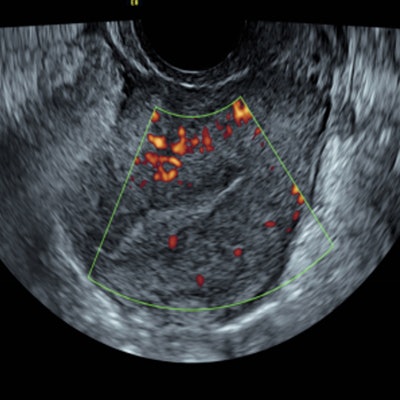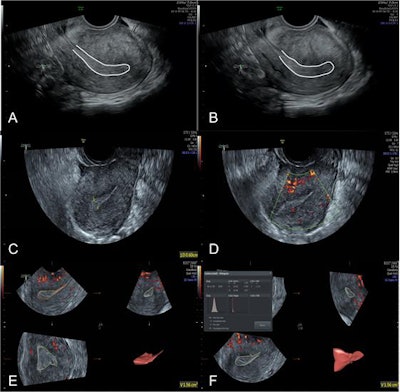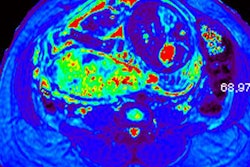
Two new research papers from China involving the use of ultrasound to evaluate endometrial receptivity and damage in patients who have had a so-called artificial abortion appear likely to generate debate -- not because of the findings but due to the unusual terminology employed by the authors.
The term "artificial abortion" is in the headline and throughout the text of both articles, which were posted online on 2 and 4 March by Insights into Imaging. The lead author of the studies is Dr. Yan Jiao from the department of radiology at the First Affiliated Hospital of Soochow University in Suzhou, China.
"I've worked in abortion care for over 20 years, attending international conferences, and have never heard of an artificial abortion, and I assume the authors mean induced abortion," a U.K.-based postdoctoral researcher told AuntMinnieEurope.com. "The authors also refer to abortion as 'an important public health problem' that can cause 'mechanical damages to the endometrium, which may lead to secondary infertility,' but this is controversial."
Also, the study sample in both papers is relatively small -- the first one involves only 68 patients who have had an abortion -- and the choice of references is narrow, focusing on nonclinical topics such as the psychological aspects of abortion, according to the source.
Multimodal scoring
The first study aimed to determine the value and feasibility of ultrasound multimodal scoring for evaluating endometrial receptivity in patients with artificial abortion. This technique can be used to assess some endometrium-related factors, such as endometrial morphology, blood flow, and peristaltic waves, Jiao and colleagues explained.
"The ultrasound multimodal scoring is based on some features of the endometrium and may provide a more comprehensive reflection of endometrial receptivity," they noted. "In the future, this scoring system has the potential to assist the reproductive physician to more accurately predict the outcome of pregnancy and plan the treatment."
 Ultrasound images of a subject in the AA group. (A, B) 2D grayscale mode; two images during observation. White curve, outline of endometrium. No endometrium peristalsis wave within 3 minutes; score, 1; (C) 2D grayscale mode; endometrial thickness, 6.0 mm; score, 1; endometrial type, type C; score, 1; (D) 2D color Doppler mode; a little blood flow in the subendometrium; score, 2; (E) 3D mode; EV, 1.56 cm3; score, 1; (F) 3D mode; VFI, 0.027; score, 2. Image courtesy of Insights into Imaging.
Ultrasound images of a subject in the AA group. (A, B) 2D grayscale mode; two images during observation. White curve, outline of endometrium. No endometrium peristalsis wave within 3 minutes; score, 1; (C) 2D grayscale mode; endometrial thickness, 6.0 mm; score, 1; endometrial type, type C; score, 1; (D) 2D color Doppler mode; a little blood flow in the subendometrium; score, 2; (E) 3D mode; EV, 1.56 cm3; score, 1; (F) 3D mode; VFI, 0.027; score, 2. Image courtesy of Insights into Imaging.Sixty-eight patients who had had an artificial abortion (AA group) and 70 women of childbearing age without any history of abortion (control group) were recruited between January 2018 and December 2018. All subjects received the examination of endometrium in the middle luteal phase (7-9 days after ovulation) with 2D grayscale ultrasound, 2D color Doppler ultrasound, and 3D ultrasound, and the quantitative scores were obtained and compared between the two groups.
The quantitative score of endometrial receptivity was 10.46 ± 2.99 in the AA group and 13.49 ± 2.21 in the control group, showing a significant difference (p < 0.05), the authors stated.
Shear-wave elastography
In the second paper, Jiao and colleagues sought to investigate the notion that shear-wave elastography (SWE) is an effective way to detect endometrial elasticity, and that assessment of endometrial elasticity by SWE may provide a better indication of early endometrial damage than measurement of endometrial thickness.
The study concentrated on nulliparous women between 20 and 30 years of age who had received ultrasound scans in 2017. These women were divided into the following groups: normal control (n = 65), after one artificial abortion (n = 68), after two artificial abortions (n = 61), and after three or more artificial abortions (n = 60). SWE was performed to evaluate the endometrium; Young's modulus of the endometrium was determined and then the endometrial thickness was measured.
"SWE increases with increasing number of abortions, which may indicate the damage that is done to the endometrium earlier than measurement of the endometrial thickness [does]," they concluded.



















